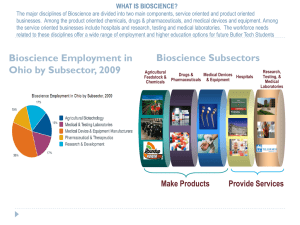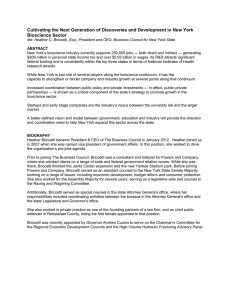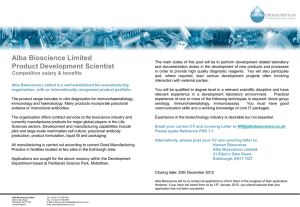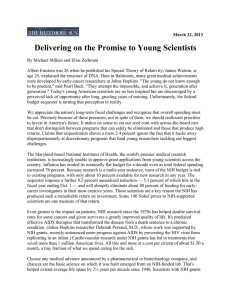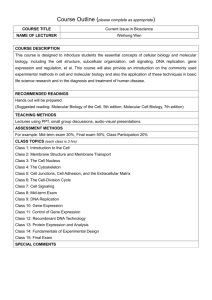Ten Reasons to Reaffirm America’s Commitment to Bioscience
advertisement
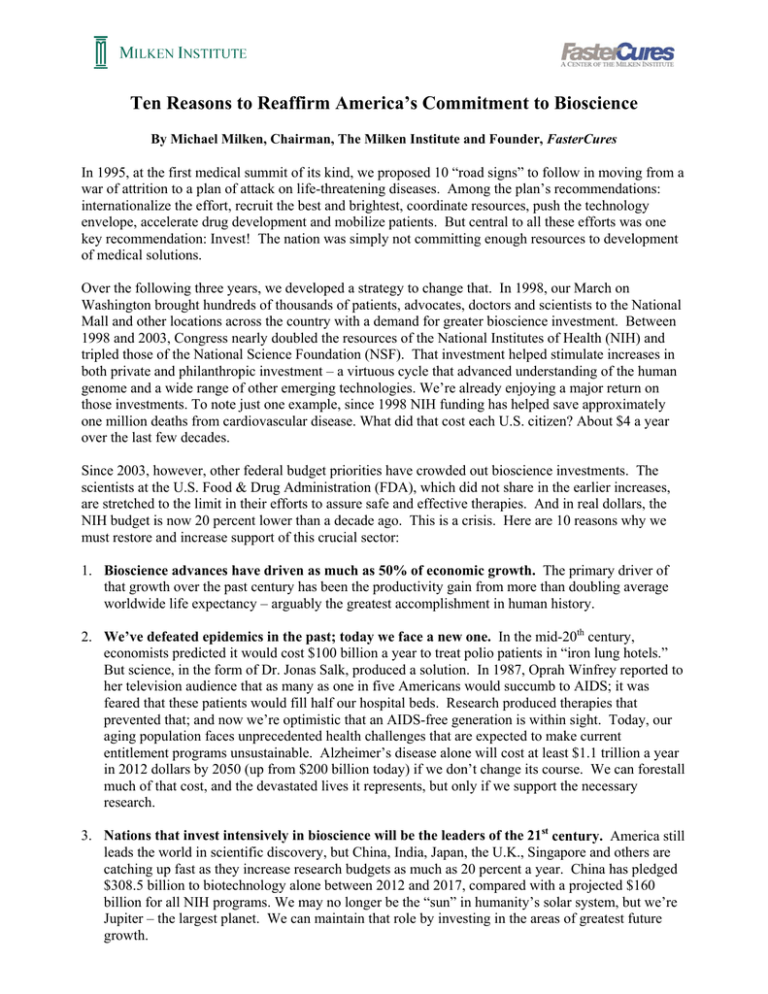
Ten Reasons to Reaffirm America’s Commitment to Bioscience By Michael Milken, Chairman, The Milken Institute and Founder, FasterCures In 1995, at the first medical summit of its kind, we proposed 10 “road signs” to follow in moving from a war of attrition to a plan of attack on life-threatening diseases. Among the plan’s recommendations: internationalize the effort, recruit the best and brightest, coordinate resources, push the technology envelope, accelerate drug development and mobilize patients. But central to all these efforts was one key recommendation: Invest! The nation was simply not committing enough resources to development of medical solutions. Over the following three years, we developed a strategy to change that. In 1998, our March on Washington brought hundreds of thousands of patients, advocates, doctors and scientists to the National Mall and other locations across the country with a demand for greater bioscience investment. Between 1998 and 2003, Congress nearly doubled the resources of the National Institutes of Health (NIH) and tripled those of the National Science Foundation (NSF). That investment helped stimulate increases in both private and philanthropic investment – a virtuous cycle that advanced understanding of the human genome and a wide range of other emerging technologies. We’re already enjoying a major return on those investments. To note just one example, since 1998 NIH funding has helped save approximately one million deaths from cardiovascular disease. What did that cost each U.S. citizen? About $4 a year over the last few decades. Since 2003, however, other federal budget priorities have crowded out bioscience investments. The scientists at the U.S. Food & Drug Administration (FDA), which did not share in the earlier increases, are stretched to the limit in their efforts to assure safe and effective therapies. And in real dollars, the NIH budget is now 20 percent lower than a decade ago. This is a crisis. Here are 10 reasons why we must restore and increase support of this crucial sector: 1. Bioscience advances have driven as much as 50% of economic growth. The primary driver of that growth over the past century has been the productivity gain from more than doubling average worldwide life expectancy – arguably the greatest accomplishment in human history. 2. We’ve defeated epidemics in the past; today we face a new one. In the mid-20th century, economists predicted it would cost $100 billion a year to treat polio patients in “iron lung hotels.” But science, in the form of Dr. Jonas Salk, produced a solution. In 1987, Oprah Winfrey reported to her television audience that as many as one in five Americans would succumb to AIDS; it was feared that these patients would fill half our hospital beds. Research produced therapies that prevented that; and now we’re optimistic that an AIDS-free generation is within sight. Today, our aging population faces unprecedented health challenges that are expected to make current entitlement programs unsustainable. Alzheimer’s disease alone will cost at least $1.1 trillion a year in 2012 dollars by 2050 (up from $200 billion today) if we don’t change its course. We can forestall much of that cost, and the devastated lives it represents, but only if we support the necessary research. 3. Nations that invest intensively in bioscience will be the leaders of the 21st century. America still leads the world in scientific discovery, but China, India, Japan, the U.K., Singapore and others are catching up fast as they increase research budgets as much as 20 percent a year. China has pledged $308.5 billion to biotechnology alone between 2012 and 2017, compared with a projected $160 billion for all NIH programs. We may no longer be the “sun” in humanity’s solar system, but we’re Jupiter – the largest planet. We can maintain that role by investing in the areas of greatest future growth. 4. Bioscience breakthroughs are among our best global ambassadors. Advances developed in America’s basic science, translational and clinical research laboratories have an impact on global health greater than all past foreign aid. In addition to helping people in developing nations, these advances also protect us from emerging diseases. 5. Young scientists are the key to the future. Over more than three decades of supporting research, the Milken Family Foundation has learned that breakthroughs most often follow investment in young researchers. Just as our nation has always sought to honor the commitments we made to veterans, we should also follow through on the implicit promises we made to the next generation of scientists. America’s leaders told these students there’s a great future in pursuing STEM education (science, technology, engineering and math). Those who did, and then persevered through as much as 15 years of undergraduate and professional training, now find shrinking opportunities. The percent of the NIH budget available to fund young investigators has fallen into single digits. If they become discouraged and pursue other career paths (or science programs in other countries), America’s economy will suffer and lives will be lost. 6. Precision medicine is here. Past investments have allowed scientists to uncover the cellular basis of disease so doctors can personalize treatments specifically for you, not just your general diagnosis. Each discovery creates promising new therapeutic targets; but without investment now, we won’t be able to develop the medicines that hit those targets. 7. A world-class ecosystem is at risk. America’s biopharmaceutical, medical device and diagnostics companies; academic medical centers; federal health agencies; and patient groups are increasingly collaborating to speed breakthrough treatments to patients. It’s far from a perfect process and we’re working to accelerate it. But these symbiotic approaches still produce more medical progress than any other nation. The federal grant system provides the foundation for this progress by funding advances in basic science. Private industry then builds on that scientific base by developing therapies with clinical potential. Let’s not starve this uniquely effective system at its source. 8. Research investments create jobs everywhere. Most federal research spending is outside the Beltway. For example, 85 percent of NIH funding is for grants that support scientists at universities and medical centers in every state, creating local jobs and driving economic growth. 9. America’s long-term strength depends on continued scientific progress. The decisions we make today will have implications long into the future. Unlike delaying construction of a bridge that can be resumed in a few years, if we lose a generation of scientists, there’s no way to rebuild that human capital quickly. We fully understand the need for overall budget restraint in Washington; but shortterm cuts in bioscience only assure a less-healthy America down the road. Modest investments in prevention and cures today will help avoid the catastrophic costs of care tomorrow. 10. Bioscience produces multiple benefits. In addition to addressing the human and economic toll of life-threatening disease, bioscience investments can help solve other significant and seemingly intractable global issues of the 21st century, including access to clean water, food production, defense against bioterrorism, energy supplies and environmental sustainability. The importance of bioscience is one of many topics we’ll address at the 16th annual Milken Institute Global Conference, April 28-May 1 in Los Angeles. This year’s Conference will continue a discussion begun in September 2012 at A Celebration of Science (www.celebrationofscience.org), an ongoing FasterCures initiative that has engaged the Majority Leaders of the U.S. Senate and House, other leaders and members of Congress from both parties, senior White House and Administration officials, biopharmaceutical CEOs, Nobel laureates in medicine and science, disease-specific patient groups, university presidents, charitable foundations, philanthropists, patients and leading medical researchers. They support a powerfully renewed commitment to bioscience through stable and sustained funding that speeds advanced therapies and cures to all patients. 2-12-13
